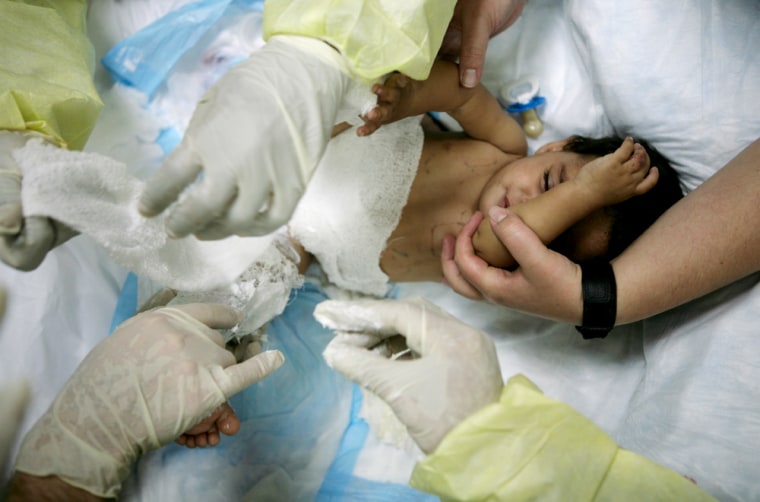U.S. military hospitals treated a significant number of wounded and sick children in the early years of the conflicts in Afghanistan and Iraq, a new study finds, and military doctors say children keep arriving at their hospitals today.
With no true front line or battle zone, the war makes children especially vulnerable to stray bullets and other combat hazards, one study author said. And with Iraq's own medical system collapsing, families seek out the U.S. military to help their children with more conventional ailments.
“I took care of children burned from a kerosene heater, regular car accidents, other injuries secondary to the conflict itself,” said study co-author Dr. Philip Spinella, who served as an Army doctor in Baghdad in 2004 and 2005.
Military doctors routinely treat children wounded by rocket-propelled grenades and roadside bombs, said Spinella, who now works at Connecticut Children's Medical Center in Hartford.
The study, published in the February issue of the journal Pediatrics, is based on Army hospital data from December 2001 to December 2004.
The situation has not changed, though. On Friday, two young Iraqi burn victims and a young Iraqi boy who underwent three surgeries for abdominal injuries and a leg amputation were being treated at the busy Air Force Theater Hospital at the U.S. air base in Balad, about 50 miles north of Baghdad.
“The majority of our patients at any given time are Iraqi nationals,” Air Force Maj. David Norton, who runs the intensive care unit there, said in an e-mail. “With respect to children in particular, we see far too many. Iraqi children, through no fault of their own, are forced to grow up quickly and are often times the unfortunate victims of an adult world.”
Hospitals resemble pediatric units
Army 1st Lt. Lee Jackson, a pediatric nurse at the Balad hospital, said in an e-mail that the ICU sometimes seems like a pediatric unit because of the number of children there. Neither Jackson nor Norton was involved in the study.
“We take great joy in the recovery of our pediatric patients and we grieve for each one that has a poor outcome,” Jackson said.
The study found that almost 6 percent of the pediatric patients in military hospitals died, a death rate similar to that of adult non-U.S. coalition patients.
The researchers, all current or former military doctors, wanted to quantify what they had seen with their own eyes. Analyzing hospital data, they discovered children made up 4 percent of admissions and 10 percent of bed-days in U.S. military hospitals in the early years of the wars in Afghanistan and Iraq.
More than 1,000 children were admitted to U.S. military hospitals during the three-year study period.
Caring for children generates enormous good will among the people of Iraq, Dr. Eaman Algobory, an Iraqi medical officer in Baghdad for the International Office for Migration, said in a telephone interview from Jordan.
“It's like an angel touched their heart,” Algobory said of the effect on Iraqis who have experienced the Army's medical care of children. “American soldiers in the field, if they see any child hurt, automatically they will try to protect them and evacuate them and try to save his life. This is well known in the street.”
She was not involved in the new study, but has worked with Spinella and other military doctors to find care for children.
Few deployed doctors and nurses are pediatric specialists, but the U.S. Army Medical Command has adapted to what the study authors called “the increased load of pediatric patients.”
Equipment adapted to suit young patients
The Army now offers pediatric trauma training to hospital staff before deployment and has added child-size equipment and liquid antibiotics to its supplies. Pediatric specialists are available by telephone.
“We've been able to overcome the difficulties,” said Spinella, who added that the study and his comments do not reflect official military or government positions.
The researchers couldn't determine how many of the treated children had combat-related injuries, said study co-author Dr. Mark Burnett of Tripler Army Medical Center in Honolulu, who served in Iraq in 2006 and 2007. The findings were based on hospital codes and the researchers did not review patient charts, he said.
The average length of hospital stay was four days. Most of the children were between the ages of 11 and 17, although 45 were infants younger than 1 year old.
“There are no battle lines, no combat zone. Kids are in the middle of it the same way everybody else is,” Spinella said.
